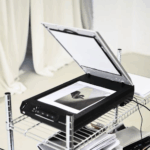Creative labeling requires thinking beyond the basics, from embracing sustainability to designing interactive experiences. Leveraging trends and technology can set your packaging apart while remaining practical and attractive to today’s consumers. Let’s explore innovative concepts brands use to boost appeal and enhance packaging functionality.
Regarding product packaging, the label is far more than mere decoration—it’s your brand’s first impression. Practical design for printed labels communicates your brand’s values, distinguishes your product on a crowded shelf, and can even foster customer loyalty. The right printed label solution lets your bottles and jars turn heads, tell a story, and create a connection with your audience in a matter of seconds.
Minimalist Elegance
Minimalist design is a popular style for skincare and specialty food brands. A clean, modern aesthetic characterizes it. It involves monochrome color palettes, sleek fonts, and minimal layout elements. This style hints at premium quality and confidence, with a single logo on off-center labels drawing attention. Emphasizing negative space and alignment adds sophistication to the design.
Full-Wrap Labels
Full-wrap labels offer branding space, allowing for bold graphics, detailed information, and storytelling elements. They are often used in beverage brands to highlight flavor profiles or ingredients, and for clear jars, semi-transparent sections create visual interest.
Custom Shapes and Die-Cuts
Move beyond the everyday rectangles and introduce custom-shaped labels for instant shelf appeal. Whether it’s a honey jar with a hexagonal label that echoes honeycomb, or a hot sauce with flame-shaped accents, a unique silhouette signals creativity and premium positioning. Die-cutting lets you use themed or seasonal shapes, create windows to highlight product textures, or layer materials for a dimensional look. Custom shapes often make a memorable unboxing or gifting experience that young, social media-savvy consumers love to share.
Eco-Friendly Materials
Modern consumers are more conscious of sustainability than ever, seeking brands that demonstrate environmental integrity. Opt for recycled paper stocks, biodegradable adhesives, or water-based inks to lessen your ecological footprint. A tactile, earthy label on a glass jar instantly communicates eco-friendliness, especially when paired with handwritten fonts or natural illustrations. Biodegradable films or materials made from plant-based sources further distinguish your products. Highlight your eco efforts on the label to assure customers you make responsible choices.
Vintage and Rustic Aesthetics
Embracing nostalgia invokes emotional resonance and can strengthen your brand’s sense of heritage or craftsmanship. Vintage typography, faded or sepia-toned colors, and faux stamps or seals work well for jams, craft beers, or artisanal pickles. Rustic labels might include kraft paper textures and hand-drawn botanical sketches for an old-fashioned, homey feel. Add an extra flourish with a twine tie or a wax seal to create a keepsake effect that invites consumers into your brand’s story.
Transparent Labels
Clear labels enhance visual appeal by letting your product take center stage. Best for vibrant liquids, layered bath salts, or colorful condiments, these labels use negative space to spotlight what’s inside. Select crisp, readable fonts in white or metallic for visibility. Minimal graphics and elegant text communicate modernity and quality at once. The transparency technique is particularly popular for brands prioritizing ingredient transparency and clean-label initiatives.
Interactive Labels
Go beyond aesthetics with labels that invite participation. Incorporate QR codes linking to recipes, how-to videos, or your brand’s sustainability practices. Thermochromatic inks that react to temperature or peel-off panels with hidden surprises can spark curiosity and social sharing. For food or beverage brands, a QR code that leads to a curated playlist or interactive cocktail recipes adds personalization and entertainment to each purchase.
Multi-Layer Labels
Multi-layer labels are ideal for jars and bottles requiring detailed information. They maintain a streamlined front and allow for usage tips, ingredient details, brand origin stories, regulatory disclosures, and multilingual communication.
Handwritten or Hand-Drawn Styles
Personal touches evoke authenticity, and consumers increasingly seek products with a story or a human touch. Labels featuring hand-drawn illustrations or faux-handwritten product names create a sense of artisanry. Imperfections like slightly uneven type or sketches of product ingredients lend charm and individuality. Pair with earthy labels or recycled glass for maximum effect.
Dual-Purpose Labels
Design labels that serve multiple purposes, such as measuring guides or writable sections for dates and notes, for pantry staples and jars, promoting sustainability and brand exposure. Innovative printed labels enhance brand loyalty and consumer trust, making products stand out.
Read Also: techinfobusiness.com



